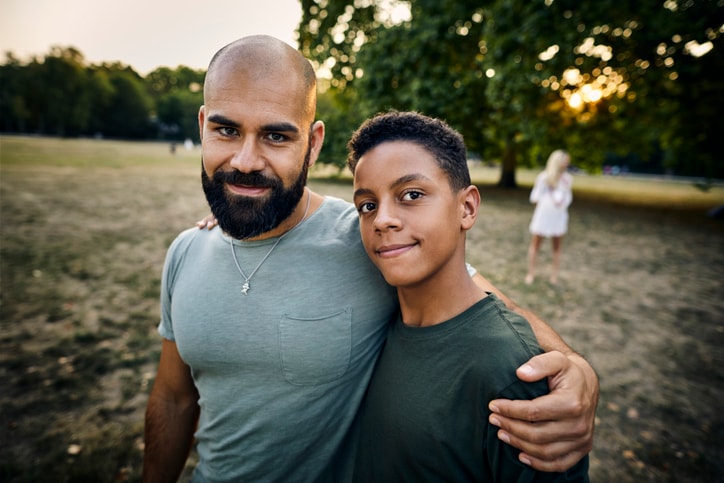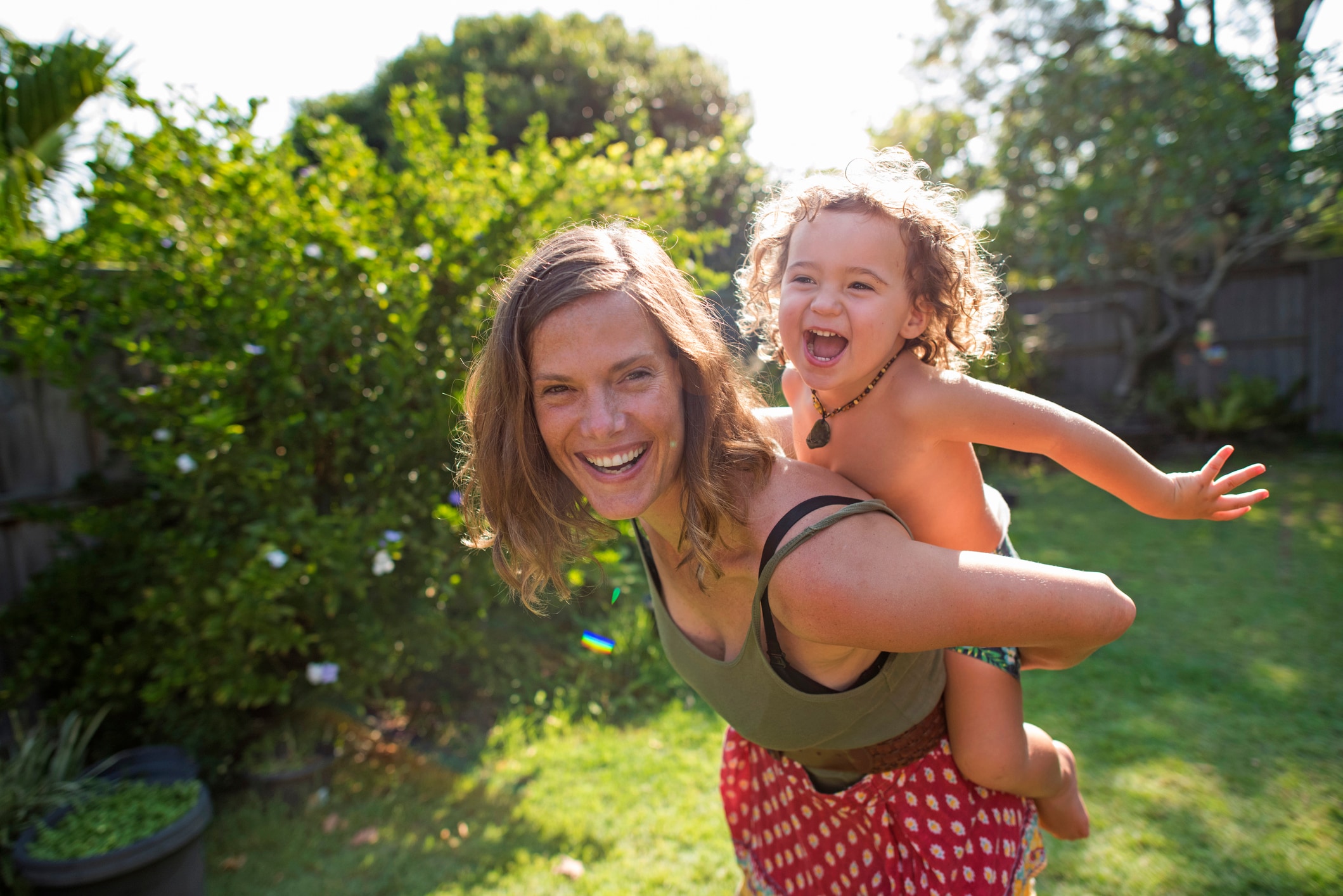While talking to girls about puberty doesn’t necessarily fall under the umbrella of “easy peasy,” talking to boys about puberty can potentially be even trickier — and not necessarily because their cringe-o-meter is dialed up higher, but because, generally speaking, boys have a tendency to be more tight-lipped than girls.
“Boys tend to be less overtly emotional about body changes,” notes Jennifer Weber, a clinical psychologist and the director of PM Behavioral Health at PM Pediatric Care. “However, these changes may create just as much anxiety, so it’s important to address the changes and not assume your son will be fine regardless.”
From physical changes to emotional ones, here’s how to make puberty for boys a little less rocky through support, love and understanding.
When do boys start puberty?
Dr. Danielle Street Stephens, a pediatrician at Holston Medical Group in Kingsport, Tennessee explains that signs of puberty in boys generally start between 10 and 11, with the American Academy of Pediatrics (AAP) giving the range of 9-14 years of age.
When does puberty end for boys?
According to the American Academy of Family Physicians (AAFP), puberty in boys is generally finished between the ages of 15 and 16, with many boys continuing to grow until the ages of 18 (or even a little older).
Physical stages of puberty in boys
According to Stephens, the following are signs of puberty in boys:
- Genital (penis and scrotum) growth.
- Darkening of the scrotum.
- Hair growth under arms and in pubic region.
- Height increases.
- Voice change.
- Acne.
- Increased sweating (which can lead to body odor).
- Nocturnal emissions or “wet dreams.”
- Facial hair. “This is one of the last symptoms,” notes Stephens.
Mental and emotional signs of puberty in boys
In addition to the concrete physical changes boys undergo during puberty, like girls, there are also “invisible” changes that include romantic and sexual feelings, social pressure and changes in mood.
“You may notice moodiness and anger during puberty as hormones rage,” Weber notes, adding that each child will experience puberty differently, which can affect their feelings and anxieties about it.
“You may notice moodiness and anger during puberty as hormones rage.”
— JENNIFER WEBER, CLINICAL PSYCHOLOGIST
“Some boys may feel self-conscious if their bodies don’t look the same as others their age,” she explains. “For instance, a boy who is heads shorter than classmates may worry about fitting in or looking too young. On the flip side, boys who experience voice cracking before others in their class may dread public speaking or acne may make them feel self-conscious in social situations.”
Tips for talking about puberty for boys
One of the best ways to discuss puberty with your child, according to Dawn Ravine, a sexuality educator and creator of the Never Fear Talks at Lurie Children’s Hospital in Chicago, is to “have lots of short talks over time instead of one Big Talk,” as the latter can feel really overwhelming to kids.
That said, if you haven’t been discussing things like body and mood changes with your child from a young age and they’re approaching puberty, that’s OK! Open the dialogue now with these tips.
Use correct language
Private parts can be an uncomfortable subject, but when you sub out slang terms for body parts, you’re driving the “awkward” message home even further, says Lori Reichel, assistant professor at SUNY Cortland, podcaster for “The Puberty Prof Podcast” and author of “Common Questions Children Ask About Puberty.”
“Always use medically accurate terminology for body parts that mature during puberty,” Reichel says. “When you don’t, it shows you’re not comfortable talking about the topic.”
Be upfront about what you know — and what you don’t
Stephens notes that parents, regardless of their gender, should have conversations with their child about puberty, “not just the one who’s the same sex.”
That being said, if you don’t know something, say so.
“Admit it when you don’t know something,” says Reichel. “When you’re stumped, refer to a reliable resource either before talking or while talking with your child. Doing this with your child models the important skill of assessing reliable resources.”
“Admit it when you don’t know something.”
— LORI REICHEL, ASSISTANT PROFESSOR, PODCASTER AND AUTHOR
Also, keep in mind: “This isn’t a one-time talk, but many conversations,” Reichel says. “As your child grows, you’ll have new and different discussions.” She adds that it’s smart to start the conversation when your child is young to set the stage that you’re there for them, but you don’t need to nail everything in one fell swoop.
Acknowledge and normalize the changes
According to Ravine, acknowledging and normalizing physical changes through an open dialogue is key.
“Are you noticing your child is spending more time alone in their room? Remind them that masturbation is normal and healthy and that touching their own body for pleasure is common for all genders,” she says. “Let them know it can be a stress reliever, a way to get to know how everything works and even help them fall asleep.”
“Things like ‘wet dreams’ and pubic hair are a part of puberty,” Weber adds. “Acknowledge the anxiety and shame that often comes with these things, but reassure your child that there is no need for this in your home.”
“Acknowledge the anxiety and shame that often comes with these things, but reassure your child that there is no need for this in your home.”
— JENNIFER WEBER, CLINICAL PSYCHOLOGIST
If you’re a parent who can relate biologically, you can share that by reminding them that you were a teenage boy too once and “leave it at that,” Weber says. “You open the door and they can walk through it whenever they like.”
Will your child recoil when you’re saying these things? Potentially. But at least you’ll have given them accurate information (as opposed to what they may hear from friends) and will have gotten the message across that everything they’re going through is normal.
Don’t shame
If your child has body odor, leave out the “yucks” and “pee-yews,” which — need it be said? — won’t exactly be a boost to their self esteem. Instead, Ravine says, encourage regular washing and deodorant use.
To that point, make sure your child follows suit with their peers by instilling kindness and teaching empathy. One way to do this? Make sure your child learns about their own body, as well as others’.
According to Ravine, kids should know about things like periods and erections, regardless of whether or not they’ll happen to them, as it helps them understand that everyone is going through changes.
“For instance, teach your child about how facial hair happens to females, too,” she says. “Many adult women remove, bleach or use makeup to cover facial hair, which can give the false impression that there is something bad about women having facial hair. There isn’t, it’s normal! If you tell your child this, and they hear kids laughing at a girl who has some facial hair, they can be ready to be the upstander amongst their peers.”
Teach diversity
Explaining diversity in puberty is another good way to build empathy and ensure kids know that whatever it is they’re feeling — they’re not alone, even if it’s not “traditional.” Ravine encourages parents to talk about “puberty patterns instead of set rules or binaries.” She also cites Gender Spectrum’s Guide to Gender Inclusive Puberty & Health Education as a great source for this.
“By doing this, you can normalize diversity,” she continues. “This sets up your child well even if their experience fits the average.”
Related: Puberty for girls: How to talk to kids about what changes happen and when
Don’t assume school covered it
Your child’s puberty education program at school may — or may not — cover the topics you’d like them to learn about. Also, your child may — or may not — have been paying attention during the lessons. In other words: Even if you’re being redundant, it’s best to talk at home, as well.
“In school, the generals are typically covered, such as the changes many or most people can expect,” Ravine says. “Conversations are also tailored to be as comfortable as possible, which means details that might be important to your child may be left out.”
Ravine also notes that there’s no standardization when it comes to puberty education in schools. She explains that programs vary from none at all to very limited to empathetic to medically accurate — which is the one she recommends.
“Medically accurate includes that there isn’t just one or two set paths for puberty, [but instead] many paths” she explains. “This is helpful in combating stigma for anyone that will have a different experience, whether that is your child or a friend.”
Leave the door open
One of the biggest things when talking about puberty for boys, according to Weber, is to simply “let your child know you’re there for them.” The goal is to make sure you’re — not TV or social media — their go-to source and their biggest supporter.
If you or your child is exceptionally uncomfortable with the subject of puberty, enlist the help of reliable books, apps or podcasts. You can either “co-read them,” according to Weber or simply leave them out for your child.
These expert-recommended books, websites and apps can help families navigate all aspects of puberty:
- Scarleteen.com. (Teen-facing, LGBTQ inclusive, articles on all aspects of sexuality, relationships and sexual health).
- Amaze.org. (Animated videos on all sexuality education topics from 4th grade to middle school.)
- Amaze.org/jr. (Geared towards younger children, pre-K through 3rd grade.)
- Sex Is A Funny Word. (Late elementary)
- Wait, What? (Middle school.)
- The Every Body Book (All ages with caregiver.)
- TALK puberty app (Help for guiding conversations.)
- Sex Positive Families. (Information and advice on a wide array of physical and emotional topics.)
Reach out to a professional
If your child seems exceptionally anxious, sad or withdrawn, you can first try “direct observation,” according to Weber, and if things don’t improve, enlist a professional.
She says: “You can say something like: ‘Honey, I noticed that you are no longer asking to have your friends over. I worry you are withdrawing. I don’t want this for you. I know a lot is changing. Are you OK? Can I help? I am here for you.’”
If they don’t open up or things stay the same (or worsen), Ravine recommends reaching out to a therapist with adolescent experience.
Whether it’s something serious like gender dysphoria or bullying or “even for just the common awkwardness and stress of having a changing body and mind, having a professional on board to support them and create a safe space is really helpful.”





